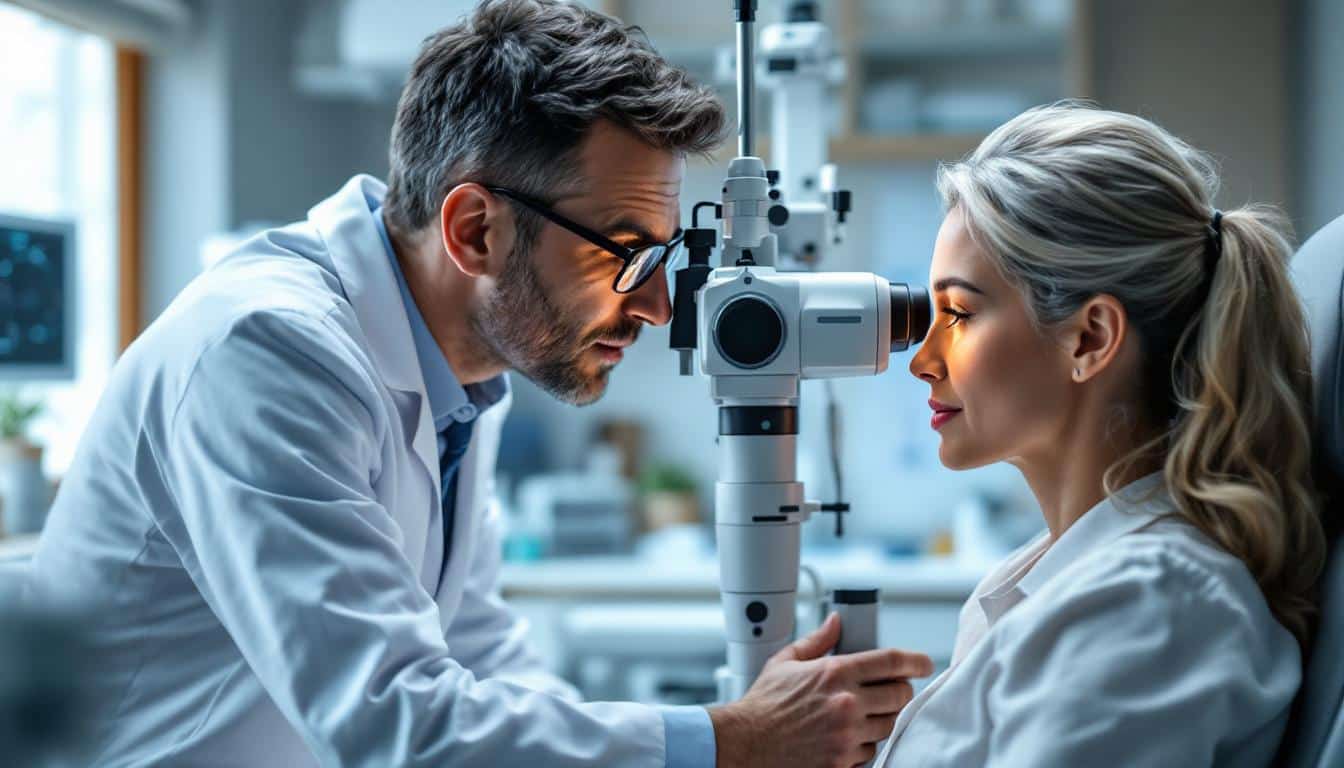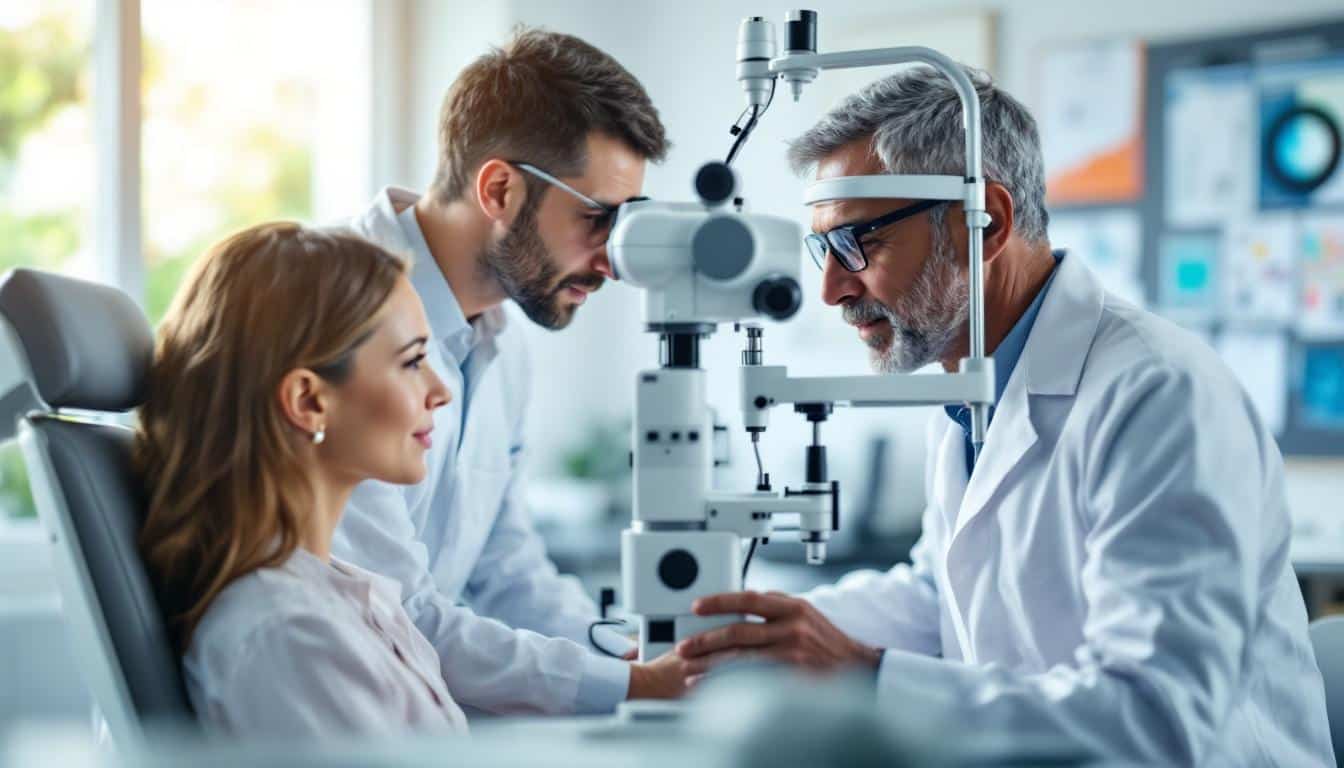“`html
The month of June is dedicated to raising awareness about cataracts.
However, visual health experts point out that the three main vision problems among older adults are cataracts, glaucoma, and age-related macular degeneration.
Fortunately, spectacular advances in surgical techniques and materials offer new perspectives for restoring and preserving vision.
These significant advancements allow for better treatment of the three major vision conditions. Increased understanding of eye health also contributes to more effective interventions. Talking with specialists like Dr. Michelle Andreoli from Northwestern Medicine in Chicago reveals the scope of possible improvements. Let’s explore these conditions and the innovative solutions that accompany them more closely.
Cataracts
When cataracts develop, the lens becomes cloudy, making vision blurry, particularly affecting night vision. Images may appear opaque or yellowed, and it becomes difficult to distinguish different colors. It is estimated that 20.5 million Americans over the age of 40 are affected by cataracts in one or both eyes, according to the CDC. The solution involves removing the natural lens and replacing it with an intraocular lens (IOL), a procedure undergone by more than 6 million Americans. Although the surgical technique for cataracts has remained similar for over 20 years, lens options have diversified to better meet patient needs. Today, several types of implants, such as toric lenses for correcting astigmatism and multifocal lenses, provide significant improvements.
Glaucoma
Glaucoma is characterized by excessive eye pressure that can damage the optic nerve. In its early stages, it has no symptoms, underscoring the importance of regular eye exams. It is estimated that 4.2 million Americans suffer from glaucoma. Treatments include eye drops to reduce pressure or surgery, or a combination of both, to prevent more serious damage. Combined cataract and glaucoma surgery, called minimally invasive glaucoma surgery (MIGS), is gaining popularity. This method uses a small incision to remove the cloudy lens and excess fluid, thereby reducing eye pressure. Furthermore, therapeutic goals have evolved, with some patients now able to stop using eye drops.
Age-related macular degeneration
Age-related macular degeneration affects the macula, a part of the retina, and can lead to vision loss without obvious symptoms. Nearly 20 million Americans are affected. Although there is no cure, treatments are available. The most common form, dry macular degeneration, affects 80% of those affected. It causes thinning of certain parts of the macula and the formation of small drusen, leading to a gradual loss of central vision. When new abnormal blood vessels grow under the retina, the condition switches from dry to wet, leading to a faster loss of vision. Treatments for the wet form include medication injections and sometimes laser surgery aimed at removing leaks from abnormal blood vessels and transforming the wet environment into a dry one.
Other findings
Regardless of age-related eye conditions, it is recommended to follow a healthy diet, wear sunglasses, and not smoke. Regular eye exams are essential, as many vision problems are asymptomatic at first but can be detected early through appropriate testing. Additionally, it is crucial to pay attention to mental health, as 1 in 4 adults with visual disorders experiences anxiety or depression.

Evaluate your eye health
Taking care of your eye health is essential for maintaining a good quality of life. As we age, various vision problems can arise, but many medical advancements today allow us to manage them effectively. In this article, we will explore the main eye disorders in adults, the available solutions, and practical tips to preserve your vision.
What are the main vision problems in older adults?
The three main eye conditions in adults are cataracts, glaucoma, and age-related macular degeneration. These disorders can seriously affect vision if not treated in time.
Cataracts
Cataracts are characterized by clouding of the lens, leading to blurry vision and decreased night vision. Images may seem yellowish or opaque, making it difficult to distinguish colors. According to the CDC, about 20.5 million Americans over the age of 40 are affected by cataracts in one or both eyes.
Fortunately, cataract surgery is an effective solution. More than 6 million Americans have undergone this procedure, which involves replacing the natural lens with an intraocular lens (IOL). Techniques and materials have evolved over the years, now offering sophisticated implants such as toric lenses to correct astigmatism and multifocal lenses that allow seeing at different distances.
Glaucoma
Glaucoma is a condition caused by excessive eye pressure that can damage the optic nerve. Often asymptomatic in the early stages, it is crucial to have regular eye exams to detect it early. Approximately 4.2 million Americans suffer from glaucoma.
Treatments include the use of eye drops to reduce pressure or surgical interventions. An increasingly popular option is combined cataract and glaucoma surgery, nicknamed minimally invasive glaucoma surgery (MIGS), which treats both conditions in one procedure.
Age-related macular degeneration
Macular degeneration affects the macula, an area of the retina responsible for central vision. This condition can lead to vision loss without obvious symptoms. Nearly 20 million Americans are affected, primarily in the dry or wet form.
The dry form accounts for about 80% of cases and is characterized by thinning of the macula and the formation of small deposits called drusen. The wet form, more severe, involves the growth of new blood vessels under the retina, which can lead to rapid vision loss. Treatments include special vitamins for the dry form and injections or laser surgery for the wet form. These advances help slow the progression of the disease and preserve vision.
What recent advances improve eye health?
Advancements in surgical techniques and materials have greatly improved the treatment of eye conditions. For instance, modern intraocular lenses offer customized options for correcting various vision problems. Furthermore, increased understanding of eye health allows for earlier, more effective interventions.
According to the Vision Center, these advances include the development of more tolerable and effective injectable medications for treating wet macular degeneration, as well as less invasive surgical procedures for glaucoma, thereby reducing risks and improving recovery times.
What daily actions can help preserve vision?
Maintaining good eye health goes beyond doctor visits. Adopting healthy lifestyle habits can significantly contribute to preserving your vision.
- Adopt a balanced diet rich in green vegetables, fatty fish, and essential vitamins for eye health.
- Protect your eyes by wearing sunglasses with adequate UV protection.
- Avoid smoking, as smoking is associated with an increased risk of macular degeneration and cataracts.
- Take regular breaks when using screens to reduce eye strain.
To learn more about lifestyle habits beneficial for older adults, check out this article on the beneficial effects of adapted communities.
Why is it important to have regular eye exams?
Many eye disorders, such as glaucoma and macular degeneration, do not present early symptoms. Regular eye exams help detect these conditions before they cause irreversible damage to vision.
According to Dr. Michelle Andreoli, an ophthalmologist at Northwestern Medicine and a spokesperson for the American Academy of Ophthalmology, “Early detection through regular exams is key to preserving long-term vision.”
Exams include an evaluation of intraocular pressure, a retina analysis, and checking the overall health of the eyes. These tests can identify early signs of disorders and implement appropriate treatments.
For proactive management of your eye health, it is recommended to schedule annual exams, or more frequently if you have a family history of vision problems.
How is mental health related to vision?
Mental health and eye health are closely linked. Untreated vision problems can lead to anxiety, depression, and a decrease in quality of life. Approximately one in four adults with eye disorders also experiences mental health issues.
It is crucial to maintain vigilance over your mental well-being if you are experiencing visual difficulties. Seeking psychological support and staying connected with loved ones can help manage these emotional impacts.
Additionally, participating in adapted social and physical activities, as mentioned in this article, can enhance your mental state and eye health simultaneously.
What treatments are available for different eye conditions?
Treatments for eye conditions vary depending on the condition and its severity. Here’s an overview of the options available for the main conditions:
Treatments for cataracts
Cataract surgery remains the most effective means of restoring vision. Advances in IOL implants allow for greater customization of treatments, providing solutions tailored to the specific needs of each patient.
Treatments for glaucoma
Treatment for glaucoma may include eye drops to reduce intraocular pressure. In more advanced cases, surgical interventions such as MIGS may be necessary to prevent damage to the optic nerve.
Treatments for macular degeneration
For dry macular degeneration, regular monitoring and vitamin supplements may slow progression. The wet form often requires medication injections directly into the eye or laser intervention to eliminate abnormal vessel leaks.
Each treatment should be discussed with an eye care professional to determine the best approach based on your specific situation.
How to choose the right eye care professional?
Choosing the right eye care professional is crucial for ensuring quality care. Look for a certified ophthalmologist with a good reputation and solid references. It is also important to feel comfortable with your doctor and to be able to communicate your concerns effectively.
Additionally, ensure that the specialist uses cutting-edge technology and offers treatments tailored to your specific needs. Do not hesitate to ask for information about different treatment options and to inquire about past patient experiences.
For more tips on healthcare professionals and best practices, visit this article.
What role do communities and the living environment play in eye health?
An adapted living environment and community support can play a significant role in preserving eye health. Well-organized communities offer resources and activities that encourage healthy behaviors and facilitate access to medical care.
Adapted communities for seniors can help maintain regular physical activity, essential for overall health, including eye health. Participating in social and physical activities can also reduce stress, positively impacting mental and eye health.
Discover how well-thought-out communities can benefit eye health in this article.
What impacts do travels have on aging and eye health?
Traveling can have beneficial effects on aging and eye health. Recent studies have shown that traveling regularly can slow the aging processes, including those affecting the eyes. Exploring new environments stimulates vision and can help maintain eye health.
Moreover, traveling offers opportunities to relax and reduce stress, which benefits eye pressure and mental health. It is important to take precautions while traveling, such as protecting your eyes from UV rays and managing your overall health effectively to reap the maximum benefits.
To learn more about the benefits of travel, check out this article.
In conclusion, assessing and maintaining your eye health requires a proactive approach that includes regular exams, healthy eating, protection against risk factors, and community support. Thanks to medical advancements, many eye disorders can be effectively treated, allowing you to preserve your vision and quality of life.
For additional information on eye care and healthy lifestyle habits, explore our other resources:
- Five benefits of adapted communities for seniors
- Let’s discuss what your third place is
- The advice of immigration and growth of technological initiatives
- A new study reveals that traveling can slow aging
- The best small dog breeds for seniors
Don’t forget to regularly consult an eye care professional and follow recommendations to maintain clear vision and optimal eye health.









